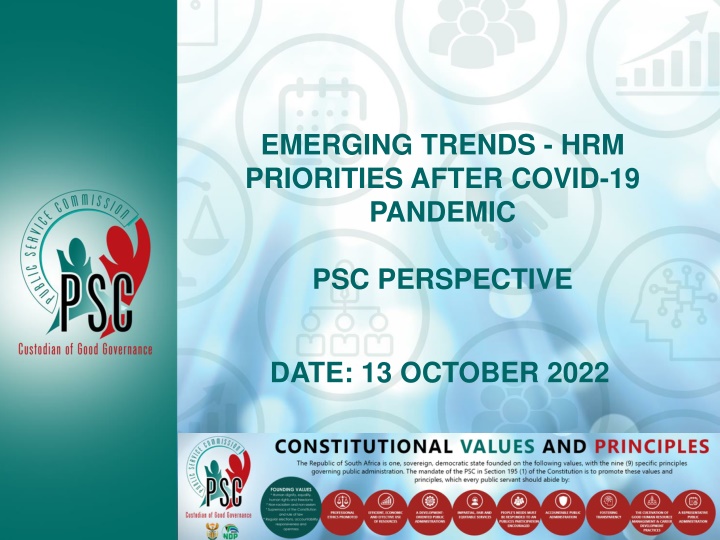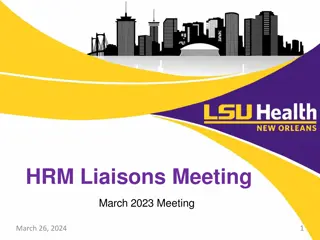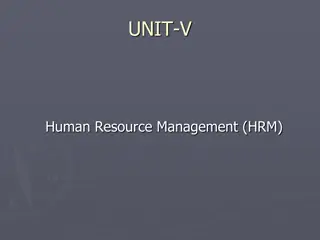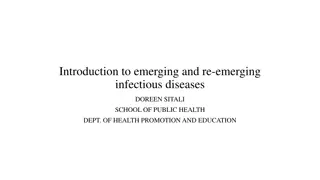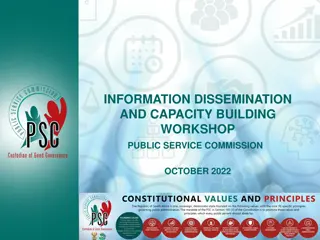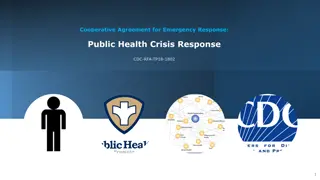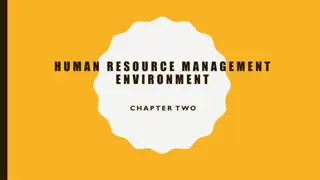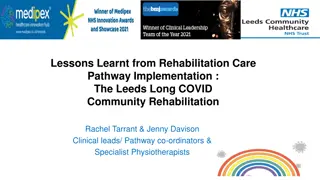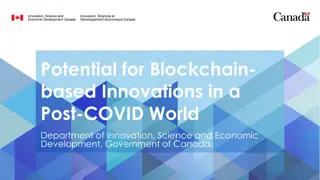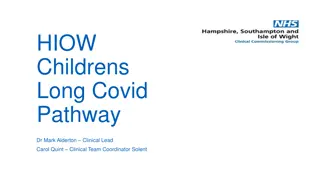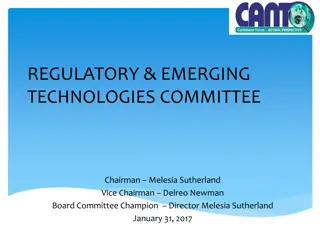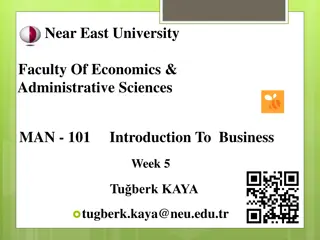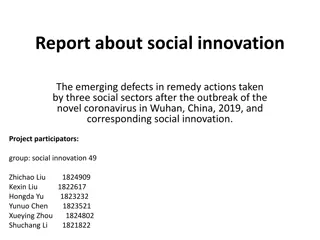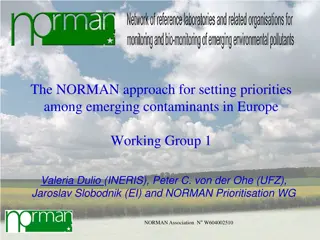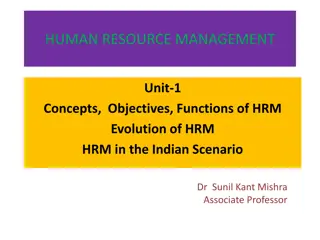Emerging Trends in HRM Priorities Post-COVID-19: Public Service Perspective
In the wake of the COVID-19 pandemic, businesses and governments globally were compelled to adapt to new ways of working, emphasizing the critical role of Human Resources Management in navigating unprecedented challenges. This presentation delves into the emerging trends and HRM priorities for the public service sector post-pandemic, focusing on critical skills, organizational design, leadership, diversity, equity, and inclusion. It highlights the need for agility in service delivery and poses key questions on making the public sector more adaptable in the face of uncertainties while ensuring efficient service delivery.
Download Presentation

Please find below an Image/Link to download the presentation.
The content on the website is provided AS IS for your information and personal use only. It may not be sold, licensed, or shared on other websites without obtaining consent from the author.If you encounter any issues during the download, it is possible that the publisher has removed the file from their server.
You are allowed to download the files provided on this website for personal or commercial use, subject to the condition that they are used lawfully. All files are the property of their respective owners.
The content on the website is provided AS IS for your information and personal use only. It may not be sold, licensed, or shared on other websites without obtaining consent from the author.
E N D
Presentation Transcript
EMERGING TRENDS - HRM PRIORITIES AFTER COVID-19 PANDEMIC PSC PERSPECTIVE DATE: 13 OCTOBER 2022
OUTLINE OUTLINE 1. Introduction 2. Framework for business agility 3. HRM priorities after Covid-19 pandemic PSC perspective a) Critical Skills and Competencies b) Organisational Design and Change Management c) Current and Future Leadership d) Diversity, Equity and Inclusion 4. Conclusion 02 HRM EMERGING TRENDS IN THE PUBLIC SERVICE DATE: OCTOBER 2022
INTRODUCTION INTRODUCTION 1. In the year 2020, the world experienced the Covid-19 pandemic, a health crisis, that closed down the functioning of businesses and governments for a couple of months at the beginning, with the relaxation of the lockdown measures as the months went by; COVID-19 forced businesses, governments and society at large to embrace the Fourth Industrial Revolution (4IR), and other new ways of working to survive in the present and in the future; It was evident during the hard pandemic periods that effective Human Resources Management is important for businesses and governments to succeed. The private sector has, to a greater degree, embraced some of the changes brought about by COVID-19 with agility by focusing on people- centred approaches to employee productivity and capitalizing on the benefits of geographically boundary-less organisation-wide capabilities. 2. 3. 4. 03 HRM EMERGING TRENDS IN THE PUBLIC SERVICE DATE: OCTOBER 2022
INTRODUCTION INTRODUCTION 5. The agility has enabled savvy businesses to utilize collaborative and creative ways of working to deliver value to a world that is characterized by ever-increasing volatility, uncertainty, complexity, and ambiguity (VUCA). However the public sector, in particular government, seems to be moving slowly, particularly in the areas of improving information technology (IT) systems (technology and digitalization) and managing human resources during times of complexity and unpredictability. The question is: What then should be done, especially in the area of HRM, to make the Public Service more adaptable to the unpredictable environment whilst still being able to deliver services to the people of this country in an effective and efficient manner? 6. 7. 04 HRM EMERGING TRENDS IN THE PUBLIC SERVICE DATE: OCTOBER 2022
FRAMEWORK FOR BUSINESS AGILITY FRAMEWORK FOR BUSINESS AGILITY For effectiveness and efficiency in service delivery, during VUCA periods the Public Service could adopt this Framework. Source: https://www.agilebusiness.org/ DATE: OCTOBER 2022 05 HRM EMERGING TRENDS IN THE PUBLIC SERVICE
FRAMEWORK FOR BUSINESS AGILITY FRAMEWORK FOR BUSINESS AGILITY The primary idea of AGILE: Appreciates individuals and interactions over compliance with processes and tools thus, placing a much greater emphasis on energising the collaborative creativity of people and how they work together. 1. Operational Agility - able to respond quickly and decisively to any new opportunities and threats that emerge and being able, with ease and consistency, to turn turbulence in their operational environment to their advantage during volatility, uncertainty, complexity and ambiguity periods. 2. Agile People are people with keen interest to develop their skills and capabilities through experience and study in learning organisations. 3. Agile Culture - creates an environment with a set of core values, behaviours and practices that allow the organisation to be more adaptive, flexible, innovative, and resilient when dealing with a world characterised by volatility, uncertainty, complexity and ambiguity. We are what we repeatedly do, Aristotle . Source: https://www.agilebusiness.org DATE: OCTOBER 2022 06 HRM EMERGING TRENDS IN THE PUBLIC SERVICE
FRAMEWORK FOR BUSINESS AGILITY FRAMEWORK FOR BUSINESS AGILITY The primary idea of AGILE (cont): 4. Agile Governance - the structures and processes for decision-making and accountability which build on a set of core agile values, behaviours and practices that allows an organisation to prosper in a world characterised by volatility, uncertainty, complexity and ambiguity. 5. Agile Leadership - nurture flexibility, resilience, and adaptability by developing others as leaders at all levels and harness the power of collective effort regardless of scale or authority; believing that people have the potential inherent in a growth mindset to deliver on a shared purpose. 6. Agile Strategy - allows flexibility and plans to evolve in response to issues or events, at a pace that s relevant to the environment that may be volatile, uncertain, complex and ambiguous. 7. Business Change Agility - A special response may be needed to handle business change that exceeds the capacity and capability of the day-to-day operational management team. HRM EMERGING TRENDS IN THE PUBLIC SERVICE Source: https://www.agilebusiness.org DATE: OCTOBER 2022 07
HRM PRIORITIES AFTER COVID HRM PRIORITIES AFTER COVID- -19 PANDEMIC PSC PERSPECTIVE PSC PERSPECTIVE There are four HRM priorities that the Public Service should focus on 19 PANDEMIC 1. to enable agility after the Covid-19 pandemic to ensure effective and efficient service delivery: a) Critical Skills and Competencies; b) Organisational Design and Change Management; c) (Current) and Future Leadership; and d) Diversity, Equity and Inclusion. 2. These four HRM priorities are regulated in the Public Service, and there is a need to focus on them more than before the pandemic. 3. Where necessary, prescripts and processes regulating these HRM priorities need to be reviewed for purposes of accommodating agility. DATE: OCTOBER 2022 08 HRM EMERGING TRENDS IN THE PUBLIC SERVICE
CRITICAL SKILLS AND COMPETENCIES CRITICAL SKILLS AND COMPETENCIES The Public Service has prescripts and processes that inform the building of critical skills and competencies, namely: Prescripts a) Public Service Act, 1994, as amended, as the primary legislation for the administration and organisation of the Public Service. b) Public Service Regulation, 2016 - regulations 74, 75, 76, and 77 make provisions for training and development interventions for building a critical skills and competent workforce in the Public Service. c) DPSA directive - utilization of the 1% personnel budget for training and development in the Public Service; and compulsory capacity development, mandatory training days and minimum entry requirements for SMS (amended April 2017). d) Internal departmental policies and Standard Operating Procedures (SOPs) in the form of bursary policies further provides guidance on how departments ought to build and strengthen capacity. 09 HRM EMERGING TRENDS IN THE PUBLIC SERVICE DATE: OCTOBER 2022
CRITICAL SKILLS AND COMPETENCIES cont CRITICAL SKILLS AND COMPETENCIES cont Processes a) Determining training needs for departments as per strategic plan. b) Skills audit to inform the training and development interventions required. c) Individual Development Plans to align with the identified priority skills. d) Granting of financial aid (bursary) or any assistance for the purpose of studying, training or conducting research in line with the skills gaps in critical areas of work. Possible interventions have Digital Learning Platforms for employees to connect and learn for themselves. The following can be the learning areas: Technological skills including cybersecurity and risk awareness; Skills needed in the future as per departmental strategy; Skills for potential successors and generally required skills for the functioning of the department; Masterclasses sharing of knowledge from experienced employees; Virtual collaboration work culture-i.e. ability to work productively, drive engagement and demonstrate presence as a member of a virtual team; and Wellness; and organisational policies DATE: OCTOBER 2022 10 HRM EMERGING TRENDS IN THE PUBLIC SERVICE
ORGANISATIONAL DESIGN AND CHANGE ORGANISATIONAL DESIGN AND CHANGE MANAGEMENT MANAGEMENT The Public Service has prescripts and processes that inform organisational design and change management, namely: Prescripts a) Public Service Act, 1994, as amended, - is the primary legislation for the administration and organisation of the Public Service. See section 41(3). b) Public Service Regulation, 2016 - regulation 25 (2) make provision for, based on the strategic plan of the department, determine, after consultation with the MPSA, the department s organisational structure in terms of its core and support functions. c) Organisational Design Directive on changes to organisational structures by departments, 2015, as amended in 2016 - amongst other objectives is to ensure that the organisational structures are responsive to the mandate and vision of the department and contribute to the attainment of the strategic objectives of the department. 11 DATE: OCTOBER 2022 HRM EMERGING TRENDS IN THE PUBLIC SERVICE
ORGANISATIONAL DESIGN AND CHANGE ORGANISATIONAL DESIGN AND CHANGE MANAGEMENT Cont MANAGEMENT Cont Process An effective organisational structure is necessary for effective service delivery. Structures are the vehicles through which services residents/citizens. a) Conduct a feasibility study and develop a business case for changes in the structure, informed by the following principles: structuring based on amended mandate or change to the strategic focus; splitting of departments; transfer of function between departments; establishment and abolishment of departments; organisational structuring based on macro-organisation of the state; re-structuring based on organisational functionality assessment and performance improvement processes; and other proposed changes that affect functional configuration and the staff establishment. b) Example - for the Public Service, in the short-term (after Covid-19 pandemic) there is no plan nor rationale to review departmental structures. are delivered to DATE: OCTOBER 2022 12 HRM EMERGING TRENDS IN THE PUBLIC SERVICE
ORGANISATIONAL DESIGN AND CHANGE ORGANISATIONAL DESIGN AND CHANGE MANAGEMENT Cont MANAGEMENT Cont c) The Public Service needs to focus on Change Management, which results from wide-spread technology adoption and the need to manage remote working arrangements, because managers are used to managing unproductivepresentism and some were equally traumatised by truancy during hybrid arrangement . Possible interventions Balance agility, empathy with employees and service delivery to the people; Promote individual and team accountability plus swift discipline management; Give employees ample information through preferred modes of communication (WhatsApp, etc.); Encourage the use of new digital tools to connect virtually, formally and informally, and inform employees about available IT infrastructure; Empower employees with tools and provide support to encourage learning and innovative ways of working; Consider changes in policies (working time, leave, etc), flexibility and adjustment in workflow processes; and Establish channels for expressing emotions and concerns in a healthy way. 13 HRM EMERGING TRENDS IN THE PUBLIC SERVICE DATE: OCTOBER 2022
(CURRENT AND) FUTURE LEADERSHIP CURRENT AND) FUTURE LEADERSHIP In the Public Service prescripts and processes that inform the current and future leadership (succession planning) are not straight forward, but found briefly in different frameworks and guidelines starting with the Constitution (founding values and section 195). The hierarchical structure of departments indirectly acts as pipeline too and gives clear career paths and development prospects to leadership. Prescripts a) Human Resource Development For the Public Service - Strategic Framework Vision 2015 - To groom and foster in-house capacity through effective career planning and talent management in departments of Government. Each department has a process to manage succession planning. b) DPSA: Guideline for Mentoring, Peer Support and Coaching for the SMS (2015) Aimed at providing an effective leadership development mechanism for enhancing human capital and improve the abilities of less experienced managers and the new cohorts of managers in the public service. DATE: OCTOBER 2022 14 HRM EMERGING TRENDS IN THE PUBLIC SERVICE
(CURRENT AND) FUTURE LEADERSHIP Cont (CURRENT AND) FUTURE LEADERSHIP Cont c) Guidelines on Integrated Human Resource Planning in the Public Service, 2002 - Departments should think how they would retain their existing employees and whether they would be able to replace critical staff members should they leave the department (succession planning). White Paper on Human Resource Management in the Public Service, 1997, Chapter 4, Section 4.2 - makes specific reference to Human Resource Planning in terms of what it should accomplish, steps involved, human requirements, human resource capacity, succession planning, and human resource strategy. Process a) Succession planning is the process of identifying very important positions in the organization and creating a talent pipeline, by preparing employees to fill vacancies in the organization as others retire or move on. b) Succession planning helps ensure business continuity and performance, particularly during times of shifting leadership and change but people must still compete for such posts. d) 15 HRM EMERGING TRENDS IN THE PUBLIC SERVICE DATE: OCTOBER 2022
(CURRENT AND) FUTURE LEADERSHIP Cont (CURRENT AND) FUTURE LEADERSHIP Cont c) Whereas succession planning generally focuses on a few positions at the very top, leadership development usually begins in middle management. d) A successor is an employee with the knowledge, skills and abilities to fill a vacant position until a permanent replacement can be identified. e) Even when there is no identifiable successor within an organization, succession planning can help identify the knowledge, skills and training needed in a future external candidate. Possible interventions maintaining a dependable supply pipeline for capable employees: Internal supply pipeline through succession planning; accelerated leadership programmes (through e.g. NSG or universities); retention strategies; or external pipeline through partnership with training organizations. 16 DATE: OCTOBER 2022 HRM EMERGING TRENDS IN THE PUBLIC SERVICE
DIVERSITY, EQUITY AND INCLUSION DIVERSITY, EQUITY AND INCLUSION The Public Service has prescripts and processes that inform diversity, equity and inclusion, namely: Prescripts a) Public Service Act, 1994, as amended, - is the primary legislation for the administration and organisation of the Public Service. b) Public Service Regulations, 2016, - regulation 27 make provision for development and implementation of an employment equity plan as contemplated in section 20 of the Employment Equity Act. c) Employment Equity Act 1998, as amended - section 6 deals with the prohibition of unfair discrimination directly or indirectly against an employee in any employment policy or practice. d) Determination on reasonable accommodation and assistive devices for employees with disabilities in the Public Service, 2015 makes provision for reasonable accommodation measures, including the provision of amenities and assistive devices will enable employees with disabilities to fully participate in the activities of departments. 17 DATE: OCTOBER 2022 HRM EMERGING TRENDS IN THE PUBLIC SERVICE
DIVERSITY, EQUITY AND INCLUSION Cont DIVERSITY, EQUITY AND INCLUSION Cont d) The Job ACCESS Strategic Framework on the Recruitment, Employment and Retention of Persons with Disabilities in the Public Service, 2009 make provision for Process a) Develop EE plan and implement it at across all occupational categories, not just SMS and/or MMS; and b) Put measures in place to support employees. Possible interventions Departments currently focus their Diversity, Equity and Inclusion (DEI) approach on shared responsibility (departmental instead of branch or unit base). There is low diversity in the leadership pipeline (levels of MMS) in terms of gender, race and people with disability and those from disadvantaged groups. This approach doesn t yield real results on DEI outcomes. Leadership must be held accountable, using a DEI approach that leads to consequential accountability; and DEI must be part of the performance agreement of all SMS (from DG to Director levels based on delegations to deal with HRM). 18 HRM EMERGING TRENDS IN THE PUBLIC SERVICE DATE: OCTOBER 2022
CONCLUSION CONCLUSION a) The presentation has shared in detail HR top priorities after the pandemic to enable departments to reflect on how best they can attend to them for purposes of ensuring departmental functionality and adaptability. b) The Public Service must come up with solutions which are impactful and responses to challenges that go beyond that which is rule-based all the time. c) DPSA must develop an updated comprehensive and integrated Human Resource Development Strategy for the Public Service, but surely departments cannot wait for the DPSA they must be guided by their mandates, technical areas of operation and international developments in such areas and this is where HRM sections must come in as real strategic partners. d) Departments must engage with the DPSA and provide proposals to guide on policy reviews or developments to accommodate the VUCA world. e) PSC will continuously provide advice to the Public Service as per its mandate and will engage with emerging policy proposals and strategies. DATE: OCTOBER 2022 19 HRM EMERGING TRENDS IN THE PUBLIC SERVICE
